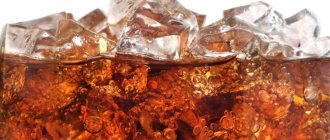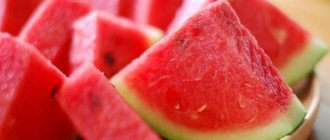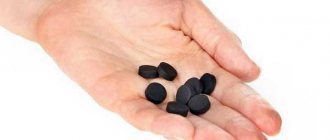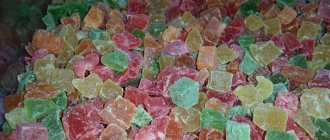Green tea is a wonderful drink whose healing properties have long been known. But if earlier people discovered them and explained them based on their own experience, now professional doctors also study them. They bring information to the masses about how many calories are in green tea.
Although it would seem that it’s just water. So what about the useful substances? Zinc or potassium in green tea - can they really be filling? Funny! But no. Green tea and calories are not an idle question and have a right to exist.
Calories in green tea without sugar
To begin with, it is worth considering the calorie content of simple tea, which does not contain sugar or any other additives. It is estimated that 100 ml of green tea contains only 1 calorie, therefore the nutritional value of a regular cup would be 2 kilocalories.
It should also be noted that the value of tea does not depend on its form: it does not matter what drink you drink, leaf or bagged. The calorie content will be the same in any case.
In bags
In addition to loose leaf tea, you can purchase tea bags, which have a whole range of benefits:
- Does not allow you to get an overly strong decoction.
- Each sachet has a strictly defined dosage, designed for one dose.
- Convenient to use - tea leaves do not fall into the mug, the liquid does not need to be filtered.
However, when buying this variety, be extremely careful - the risk of buying a low-quality product in bags is much higher. To protect yourself, pay attention to the assortment of the Russian Tea Company.
Calories in green tea with sugar
Sugar is the most popular additive in tea, but it is also the most harmful and one of the most high-calorie ingredients. So, 1 teaspoon of sugar contains as many as 16 kilocalories. Therefore, as the number of spoons increases, the overall energy value increases.
For example, let's take the standard option for drinking tea: 2 tsp. sugar per regular cup, the volume of which is 200 ml. If you add up all the above values, you can come to the conclusion that the calorie content of such a cup will be approximately 34-35 kilocalories. Accordingly, if you drink tea 3 times a day, you will get as much as 105 kilocalories from it alone, although it seems that tea is just colored water that has no nutritional value.
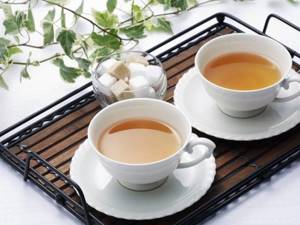
Thus, if you are trying to lose weight and carefully calculate your daily calorie intake, then you should avoid adding sugar.
Nutritional table
For a better understanding of the information presented, a sign is attached below, with which you can correctly calculate the value of the drink.
| Product | Fats/Proteins/Carbohydrates (per cup) |
| Sugarless | 0/0,47/0 |
| With sugar | 0/12,51/0,02 |
| With honey | 0/13,66/0,05 |
| With lemon | 0/0,82/0,18 |
Calorie content of green tea with ginger
Ginger is not only an aromatic spice with a spicy-sweet taste, but also an effective weight loss remedy that accelerates the breakdown of fat deposits. As a rule, green tea is simply brewed in the usual way, and the ginger root is crushed and added to the teapot at the rate of 20 g of ginger per 400 ml of water.
With these proportions, the calorie content of ginger infusion will be 18 kilocalories per 200 ml. If you combine it with the value of the tea itself, it turns out that one cup of green tea with ginger contains 20 kilocalories. Not so little, but also significantly less than in the case of added sugar.
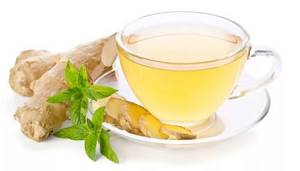
Kinds
Today the most popular for weight loss are:
- Gunpowder. It differs in its production method - the leaves are manually rolled into small lumps, thanks to which the taste and aromatic properties are preserved longer.
- Matcha. Vitamin C, which is contained in large quantities in this drink, helps strengthen the immune system, eliminate toxins and normalize blood pressure.
- Golden turmeric. Pineapple pieces combined with Chinese green tea give a unique sweetish taste and also have an immunostimulating effect on the body.
- Silhouette. The name speaks for itself - this is what those who want to lose weight and get in shape need, a composition rich in vitamins (rose hips, licorice, hawthorn, juniper, strawberries, chamomile, nettle leaves and cinnamon)
- Sen Cha. A popular Chinese drink made using Japanese technology. The key feature is steam treatment during the fermentation process. The leaves begin to be collected at the end of May, when they have already ripened and bloomed. It is believed that a decoction based on them can instantly put you on your feet and improve your health.
You need to try all the listed varieties to understand which one can fully satisfy your taste needs.
Calorie content of black and green tea
The calorie content of black tea is slightly higher than that of the green variety. The difference is explained by the fact that black tea undergoes a deeper fermentation during the production process, during which complex compounds with increased energy value are synthesized. It is also worth noting that dry brewing of different types of tea has different calorie content (per 100 g):
- black long tea, pu-erh – 151.8 calories;
- white, yellow, green tea, oolong – 140.9 calories.
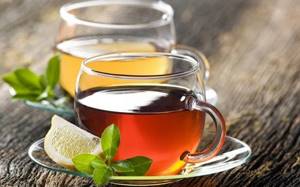
If you recalculate the nutritional value of the finished infusion, it turns out that 100 ml of black tea contains only 3-5 kilocalories. To simplify calculations, the average value (4 kcal) is usually taken.
Thus, the calorie content of black tea is 4 times higher than the calorie content of green tea (8 and 2 kcal per cup of the first and second drink, respectively). In reality, such a low value will not affect your daily diet in any way, so you can safely drink any tea to your liking.
Can you lose weight with green tea? This video will tell you how to brew and take it correctly.
Harm
Green tea varieties began to gain wide popularity back in ancient times. Thus, Japanese and Chinese healers used them to eliminate a variety of diseases and ailments. To date, the benefits have been confirmed in the laboratory: due to its unique chemical composition, it has a whole range of medicinal properties.
In addition, the drink can cause harm to the body in the following cases:
- with tachycardia and increased excitability;
- for sleep problems, in particular insomnia;
- when replacing water with tea, you can become dehydrated, significantly worsen your skin condition, and also cause the development of pathological processes in the kidneys;
- an excessively strong decoction negatively affects the walls of the stomach, promoting the formation of new ulcers and worsening gastritis;
- uncontrolled use during pregnancy or lactation can adversely affect the health of both the woman and the child.
Key contraindications for consumption include: nervous exhaustion and chronic fatigue; diagnosed insomnia; peptic ulcer and gastritis; gout; tachycardia; hypotension.
Does green tea burn calories?
It was already mentioned above that green tea is considered an effective remedy for weight loss. The fact is that it contains a large number of different vitamins, microelements and valuable substances, some of which can accelerate energy processes in the body.
Thus, thanks to polyphenols, metabolism accelerates. Scientists estimate that drinking 4 to 6 cups of green tea per day can speed up metabolism by 20-35%. In addition, tea promotes accelerated absorption of complex fats and the breakdown of accumulated fat deposits. The combination of these properties suggests that green tea actually burns fat to a certain extent.
In addition, tea has a diuretic effect and can also reduce appetite by normalizing blood sugar levels. All this additionally helps to lose excess weight.
Despite all of the above, you need to understand that green tea is not a magic remedy that will immediately rid you of unwanted pounds. The beneficial properties of the drink can only stimulate weight loss, subject to proper diet and exercise.
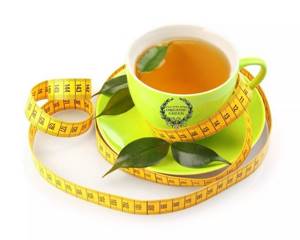
The calorie content of green tea is very insignificant, but it must be borne in mind that adding sugar or other similar ingredients dramatically increases the energy value of the drink. In order to lose weight, it is better to add ginger to tea, which will help break down fat deposits. However, it is important to understand that even the most healthy and low-calorie tea cannot lead to instant weight loss.
Compound
Green tea is tea that has undergone a minimal degree of fermentation or oxidation. Like black, it is obtained from the leaves of the tea bush, however, the methods of collecting and processing the raw materials differ. Among the basic technical principles:
- preliminary fixation with steam at a temperature of 170 to 180 degrees for up to two days;
- no heating stage in pots;
- the oxidation degree ranges from 3 to 12 percent.
To date, there are many different varieties of green tea, each of which has specific features and characteristics. They are determined by the growing environment, collection methods, and processing technology.
Due to its unique properties, the product often becomes the object of scientific research. In this case, the focus of attention, as a rule, is on the chemical composition. For example, one of the latest laboratory works made it possible to establish that more than 50% of all components are tannins.
Conventionally, all components of the product can be divided into three groups:
- vitamins;
- minerals;
- active substances.
As for vitamin complexes, the highest concentrations are:
- thiamines (group B1) – 0.06-0.07 mg;
- retinols (A) – 0.05 mg;
- riboflavins (group B2) – 1 mg;
- ascorbic acids (C) – 10 mg;
- niacin equivalents (PP) – 11.32 mg.
The mineral composition includes all the elements necessary for normal life - potassium, magnesium, sodium, iron, phosphorus, calcium, and fluorine. Of the active substances, worthy of mention are catechins, which have a general strengthening and tonic effect, tocopherols, which have a pronounced antioxidant effect, and caffeine, which is designed to invigorate, give strength and energy.
Features of product production
Tea leaves are collected in the warmest and most picturesque places in the world: India, Sri Lanka, Japan, China, Africa. There are several ways to collect the “harvest”: machine and manual [3]. Companies that produce premium quality tea use the second method. Workers manually collect only the top two leaves and a bud: it is in this part of the plant that the special aroma, taste and benefits are concentrated. This collection method is called two leaves and one bud. Everything below the bud and the first two leaves is used by companies that focus on quantity rather than quality [4].
After picking, the tea leaves are dried. This happens in specialized "tea gardens". The moisture is completely removed from them and they become like fallen autumn leaves. Next, the dried tea base is sent into a huge drum, which gives it the required shape. Most often, manufacturers use a spiral shape or a regular straight line.
Only after these three stages - picking, withering and rolling - are the tea leaves fermented. During the oxidation process, separation into green/black/white and other varieties occurs.
Remember: green tea is not specially fermented. This process occurs naturally within the raw material itself at some stages of production, but the degree of oxidation of the finished product is minimal.
In Japan, handfuls of dried leaves are placed in steam drums, and in China, they are placed in huge hot frying pans for 30 seconds [4]. The enzyme cell juice of the raw material is deactivated and fixed in the tea leaf. What does it mean? The oxidation process does not start inside the plant, so the tea retains its natural color and rich nutritional composition.
The final stage is drying. The sheets are simultaneously dried and sorted. The product must match in color, structure, shape and size. During sorting, tea dust, seedings and broken pieces are sifted out.





